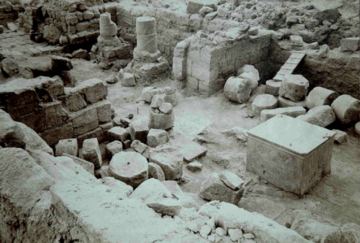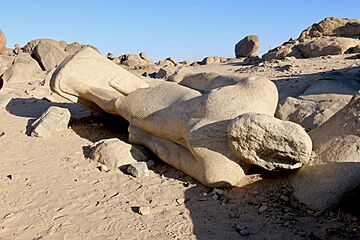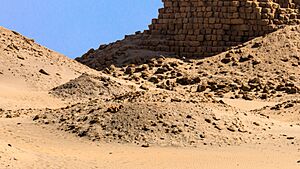Atlanersa facts for kids
Quick facts for kids Atlanersa |
|
|---|---|
| Atlanersa | |

Colossal granite statue of Atlanersa from his Osiris-Dedwen temple at Jebel Barkal, now in the National Museum of Sudan
|
|
| Kushite king of Napata | |
| Reign | c. 653–643 BC |
| Predecessor | Tantamani |
| Successor | Senkamanisken |
| Consort | Khaliset, Malotaral, Yeturow Uncertain: Peltasen, Taba[..], K[...], Amenirdis II |
| Children | Nasalsa ♀ Uncertain: Senkamanisken ♂ Conjectural: Amanimalel ♀ |
| Father | Taharqa or less likely Tantamani |
| Mother | Queen [..]salka |
| Born | c. 671 BC |
| Died | c. 643 BC |
| Burial | Nuri (probably Nu. 20) |
| Monuments | Pyramid Nuri 20 Jebel Barkal Temple B700 Uncertain: mortuary chapel Nuri 500 |
Atlanersa was a powerful king of the Kushite kingdom in Nubia. He ruled for about ten years in the middle of the 7th century BC. Atlanersa took over from Tantamani, who was the last ruler of the 25th Dynasty of Egypt.
He was likely the son of Taharqa, another important king, or possibly Tantamani. His mother's name is only partly known. Atlanersa's rule began right after the Nubians lost control of Egypt. This happened when the Assyrians conquered Egypt. After this, Egypt entered a new period under Psamtik I. During Atlanersa's time, the Kushite culture started to adopt more Egyptian beliefs and customs.
Atlanersa might have been the father of Senkamanisken, who became king after him. He built a pyramid for his burial in Nuri, which is thought to be Nuri 20. He also started building a special chapel there. Atlanersa was the second Nubian king to build a pyramid in Nuri, following Taharqa. Many small items found in his pyramid are now in the Museum of Fine Arts in Boston, USA. His most famous building is a temple dedicated to the god Osiris-Dedwen at Jebel Barkal. This temple, called B700, was not fully decorated when he died, suggesting his death was sudden. A huge statue of Atlanersa from this temple is now in the National Museum of Sudan.
Contents
Royal Family of Atlanersa
Parents of King Atlanersa
Atlanersa was the son of King Taharqa. Some experts think he might have been the son of Tantamani, who ruled just before him. However, most believe Taharqa was his father.
If Taharqa was his father, Atlanersa might have been too young to become king right away. This could be why Tantamani ruled for a while first. It's also possible that the Napatan society preferred older, more experienced kings. If a young heir was not ready, an older relative might rule until the heir grew up.
Atlanersa's mother was a queen whose name ended in [...]salka. Her full name is not known today. She was called "Great one of the Imat-scepter, noblewoman."
Wives and Children of Atlanersa
Atlanersa had at least two wives who were also his sisters: Yeturow and Khaliset. Yeturow was called "wife of the king, daughter of the king, sister of the king, mistress of Egypt." Khaliset was a "noblewoman" and "great daughter of the king."
Khaliset was likely meant to be the mother of the next king. But it seems another wife, Malotaral, was the mother of Senkamanisken, who became king after Atlanersa. Senkamanisken might also have been Atlanersa's brother. Other possible wives include Peltasen, K[...], and Taba[...]. It is also possible that Amenirdis II, a powerful priestess in Thebes, was married to Atlanersa and was his sister.
Atlanersa had at least one known daughter, Queen Nasalsa. She married Senkamanisken and was the mother of future kings Anlamani and Aspelta. Queen Amanimalel might also have been his daughter.
Important Buildings and Discoveries
Temple B700 at Jebel Barkal
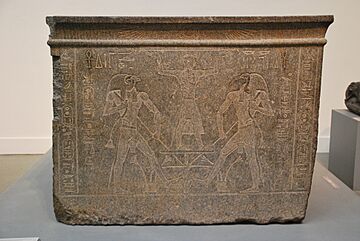
Tablets found with Atlanersa's name show that he started building a temple at Jebel Barkal. This temple, known as B700, was for the god Osiris-Dedwen. Jebel Barkal was chosen because it was near a sacred mountain. There was also an older, smaller chapel there. It's not clear if Atlanersa destroyed the old chapel or if it was already in ruins.
The temple is now ruined. It had a large entrance, a small courtyard, and an inner sacred room. Both the courtyard and the inner room had columns. The inner room had a long hymn to Osiris written on its walls. This hymn might have been about the dead king Taharqa. The walls also showed scenes of the king's coronation, but most of these are gone now.
Under two corners of the inner room, special deposits were buried when the temple started. These included tablets with Atlanersa's name. In the middle of the sacred room was a stand for a sacred boat. This stand was made from a single piece of granite weighing over 8 tons. It was used to hold the boat of the god Amun of Napata when it visited the temple.
Atlanersa's name was also on the front entrance of the temple, which is now destroyed. Much of the decoration was added during Senkamanisken's rule. However, it showed queens Yeturow, K[...], and Khaliset, who were Atlanersa's wives and sisters. Atlanersa's name was also on a granite altar in the temple.
The way the temple was built suggests Atlanersa died suddenly. He finished the main construction and decorated the inside rooms. But he did not finish the outside decoration. This was completed by Senkamanisken, who added his own writings and a small stone pillar. A huge statue of Atlanersa was placed at the temple entrance. It was found fallen over with its head cut off. It is now in the National Museum of Sudan.
Pictures on the boat stand and temple walls show Atlanersa holding up the heavens. They also show him performing a ceremony called "uniting the two lands." This ceremony was originally for Egyptian pharaohs. It later became an important part of Kushite kingship. This shows that Atlanersa ruled at a time when Kushite culture was taking on more Egyptian ideas. The temple was important for a new king to be confirmed by the god Amun. Later, it might have been a temple for all dead Kushite kings.
Other Discoveries
Atlanersa's statue was not found in a group of statues discovered in Jebel Barkal Temple B500. Statues of other kings like Tantamani and Senkamanisken were found there.
A small seal of Atlanersa, now in the Louvre Museum, might have come from Thebes in Egypt. In Old Dongola, a broken stone pillar with Atlanersa's name was found. It was reused as a column in a church.
Near Tombos, an unfinished statue was found in a quarry. It was the same size and stone as Atlanersa's statue from B700. It was likely meant to be the second statue at the entrance of B700 but cracked during carving. It almost certainly represents Atlanersa.
Atlanersa's Tomb
After digging at the burial site of Nuri, experts believe pyramid Nuri 20 belongs to Atlanersa. This pyramid is the second oldest in Nuri, after Taharqa's. Atlanersa was the second king to choose Nuri for his burial. This suggests he was Taharqa's son and wanted to be buried near his father.
The pyramid is made of sandstone and has a steep slope. It has a small chapel next to its eastern side. Inside the chapel was an offering stand and a table made of granite. The table once had carvings and hieroglyphs, but they are now hard to read.
The burial chambers were reached by a staircase of 36 steps. A wall was built at the end of the stairs to stop thieves. There were two rooms: an antechamber and a larger burial chamber. The burial chamber contained parts of canopic jars (jars used to store organs), clay figures of gods and goddesses, and pieces of precious stones. It also had many small faience figures called shawabtis. These were meant to serve the king in the afterlife.
Many other items were found in the pyramid. These included pieces of jars, stone vessels, bowls, and a scarab (a beetle-shaped amulet) made of beryl with gold wire. Gold foil pieces, a pendant with Atlanersa's name, and Menat amulets (rattles used in religious ceremonies) were also found. Many of these items are now in the Boston Museum of Fine Arts.
A nearby rectangular building, Nuri 500, might have been a funeral chapel. An alabaster tablet found there also had Atlanersa's name on it.
Political Situation During Atlanersa's Reign
Timeline of Atlanersa's Rule
Atlanersa was likely born around 671 BC. He ruled for about ten years, from around 653 BC to 643 BC. This time is known as the early Napatan period in Nubian history.
He lived at the same time as the Assyrian king Ashurbanipal and the Egyptian pharaoh Psamtik I.
End of the 25th Dynasty
By the end of King Taharqa's rule, the 25th Dynasty was in trouble. They were losing a war against the Neo-Assyrian Empire. Around 665–664 BC, Taharqa and Tantamani lost control of northern Egypt to Assyrian rulers.
In 663 BC, Tantamani briefly took back the city of Memphis. But he was defeated by Ashurbanipal, who then sacked the city of Thebes. The Kushites became weaker. They could not stop the rise of the Twenty-sixth Dynasty of Egypt under Psamtik I. Psamtik I quickly moved south and drove Tantamani out of southern Egypt around 656 BC.
So, unlike the kings before him, Atlanersa's kingdom was only in the region of Kush, south of Elephantine. His main city was Napata. However, the Kushites still had some influence in the Theban region of Egypt.
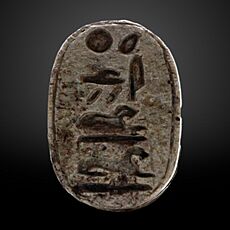
Even though he only ruled Kush, Atlanersa used the same royal titles as Egyptian pharaohs. He called himself "Son of Ra" and "King of Upper and Lower Egypt." His inscriptions said that the gods promised him rule over Egypt because of his temple B700.
Atlanersa's Horus name, "Founder of the two lands," was similar to titles used by earlier Egyptian kings. This shows how much Kushite kings adopted Egyptian royal traditions.
Some historians thought that Atlanersa or Senkamanisken might have faced attacks from Egyptian troops under Psamtik I. However, there is no direct proof of this. A raid on Napata by the Egyptians did happen later, around 593 BC, during the reign of Psamtik II. During this attack, the huge statue of Atlanersa in front of Temple B700 was knocked over and its head was cut off.
See Also
- List of monarchs of Kush
Sources
| Preceded by Tantamani |
Rulers of Kush | Succeeded by Senkamanisken |


